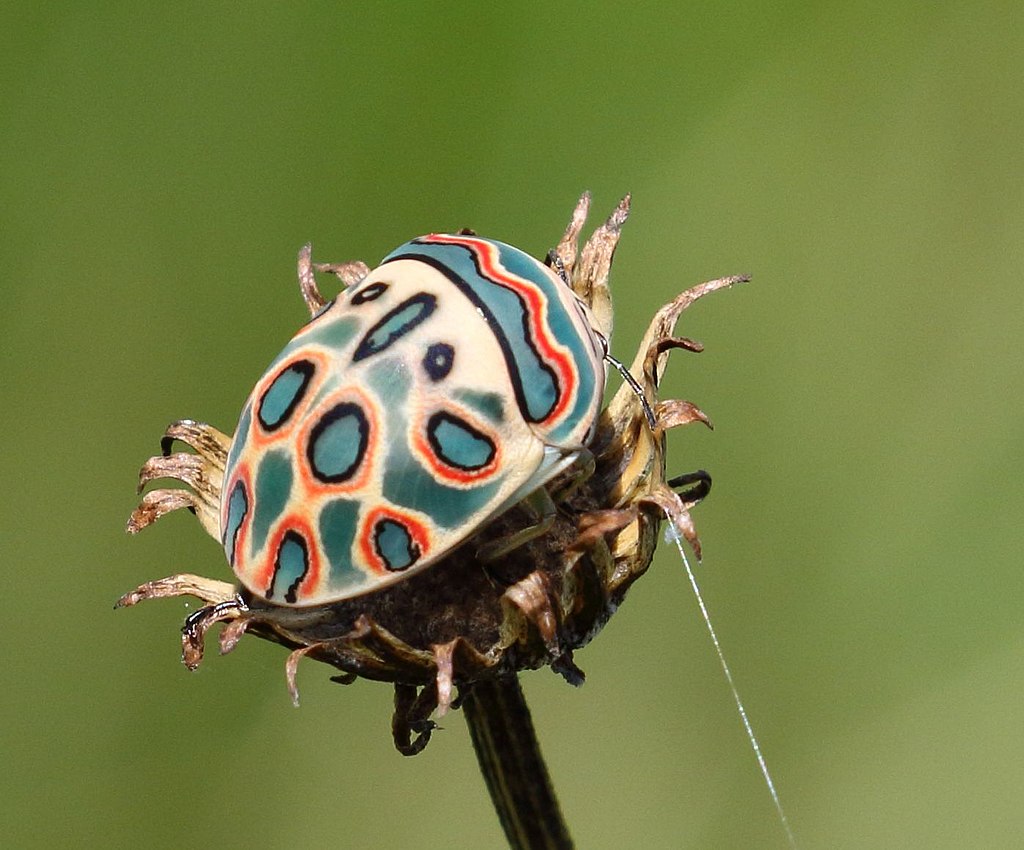It’s Pride Month so to celebrate we’re looking at a colourful animal just like the Pride flag. In fact this animal is so colourful that it is named after an artist – Pablo Picasso. This week we’re looking at the Picasso bug.
Taxonomy and Evolution
The Picasso bug has a few other common names including the Zulu hud bug and the iCikwa. All these names refer to the same species, Sphaerocoris annulus. They are one of twenty species of Sphaerocoris, a genus belonging to the order Hemiptera. This means that Picasso bugs are actually bugs, a vast order of insects with at least 88,000 identified species. Picasso bugs belong to a specific family of bugs called Scutelleridae, the jewel or metallic shield bugs, which are so named for their bright colours.
Biology and Behaviour
These bugs are little reaching between 9 and 12 millimetres meaning they can easily fit onto your thumb nail. At first glance you could mistake them for a beetle, and it is understandable as jewel bugs have similar body plans to many beetles. After all, it is a good body plan as evident by the over 400,000 species of beetle. Like beetles, Picasso bugs have wings which are under a hard scale called a scutellum, although these bugs are not strong fliers only doing so in short bursts to escape threats. It is these scutellum that gives Picasso bugs their name as they are so brightly coloured with 11 ring-shaped spots on it. Each Picasso bug has a unique pattern with a mix of light green, cream, black, and red colours making them a little splash of colour in the animal world.
Picasso bugs evolved these colours for a very specific reason. Animals, especially insects, evolve bright colours as a way to communicate, and for invertebrates colours are generally a warning. Being tiny makes them on the menu for many larger animals so the colours tell potential predators ‘go after me if you dare’. In some animals it means they are toxic, but for Picasso bugs it means they pack a punch. As jewel bugs Picasso bugs are one of the many bugs known as ‘stink bugs’, which means they are capable of producing a noxious chemical that it sprays at threats. Even if the chemical is not harmful it can stick to the body of predators which can impact their ability to hunt or hide from larger predators.
Unlike beetles or butterflies bugs do not go through a metamorphosis stage. Instead, nymphs hatch resembling adults, and Picasso bugs do this as well. During the dry season, October to December, females lay up to 400 eggs on the underside of leaves hatching when flowers go into bloom. Nymphs are not as brightly coloured as the adults eventually getting their bright colours by moulting over a period of fifty days. Both nymphs and adults like to cluster together, safety in numbers after all.
Distribution and Habitat
For a third week in a row we are looking at something that is found across sub-Saharan Africa. From Sierra Leone in the west to Ethiopia in the east, and from southern Chad to South Africa they have an incredibly wide distribution. This also means they are found in a variety of environments, particularly wetter habitats with them not being as common in drier scrublands and grasslands.
Diet and Predators
Picasso bugs are herbivores with their diet changing as they develop from nymphs to adults. Nymphs normally eat flowers whereas adults go with the entire plant. Bugs like Picasso bugs have a proboscis which they inject into the body of the plant and use it as a straw to drink up. In particular, Picasso bugs love coffee, cotton, and daisies, although they are not limited to these plants. Thanks to their bright colours Picasso bugs do not have many predators but they can be eaten by frogs, small mammals, lizards, birds, spiders, scorpions, centipedes, and larger insects.
Conservation and Threats
A few of the sources I have used cite Picasso bugs as not being endangered according to the IUCN, although I cannot find them in the IUCN database. Overall, from this, I would say that Picasso bugs are not endangered being found over so many countries and habitats. However, things could go wrong in the future. Desertification threatens many of the habitats they have been found in which pushes them into areas demarcated for human crops. With them especially being fond of coffee and cotton plants this can put them into direct conflict with humans and their pesticides.
Bibliography:
- Ben G Thomas, ‘Picasso Bug – Animal of the Week’, YouTube.com, (04/07/2022), [Accessed 15/06/2024]
- Warren Dick, ‘Nature’s calling – Picasso bug’, Southlands Sun, (15/01/2021), [Accessed 15/06/2024]
- Todd Sain, ‘Picasso Bug: Smelly but Amazing’, Our Breathing Planet, [Accessed 15/06/2024]
- David Burnie and Don Wilson, (eds.), Animal: The Definitive Visual Guide, (London: DK, 2017)
